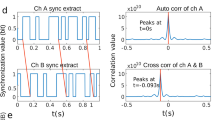Summary
This method provides a reliable means to determine distance between vocalizing individuals and their locations through a prolonged period of time without disturbance to the communication process by the presence of an observer. The accuracy of this method was tested by varying the arrival time differences on the microphone grid for known locations in a random fashion. This test shows that a vocalizing animal within an area of 4 ha surrounding the microphone array can be localized with an accuracy of ±1 m. The accuracy decreases with the distance from the central area and as a function of the geometry of the array. The location of an individual can be determined based on 5 vocalizations given in sequence.
Similar content being viewed by others
References
W.M. Schleidt, The Noisy Channel, vol. 1, p. 1. University of North Dakota, Grand Forks 1973.
W.A. Watkins and W.E. Schevill, Deep Sea Res,19, 691 (1972).
Author information
Authors and Affiliations
Additional information
Acknowledgment. This research was supported by funds granted to Irene Magyar from the Chapman Fund, The American Museum of Natural History and Sigma Xi, Grants in Aid of Research.
Rights and permissions
About this article
Cite this article
Magyar, I., Schleidt, W.M. & Miller, B. Localization of sound producing animals using the arrival time differences of their signals at an array of microphones. Experientia 34, 676–677 (1978). https://doi.org/10.1007/BF01937030
Published:
Issue Date:
DOI: https://doi.org/10.1007/BF01937030




